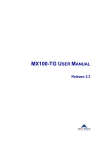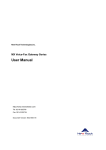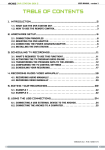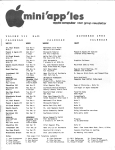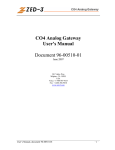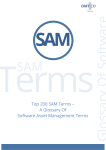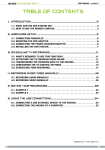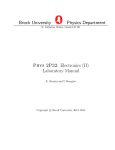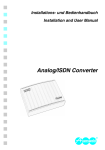Download MX100-TG USER MANUAL
Transcript
MX100-TG USER MANUAL Release 3.0 Software License Agreement Any software product, including any documentation relating to or describing such software (hereafter collectively called “Software”), provided by New Rock is furnished to you for installation and use on a single computer. The Software may not be copied, in whole or in part, except for archival purposes, to replace a defective copy, or for program error verification. You may not reverse engineer, decompile, or disassemble the Software, except to the extent such foregoing restriction is expressly prohibited by applicable law. Unless earlier terminated by New Rock as herein provided, the term of each paid-up license shall expire at such time as you discontinue use of the applicable Software on the single processor specified above but otherwise shall be without restriction as to time. The Software (including any images, applets, photographs, animations, video, audio, music, and text incorporated into the Software) is owned by New Rock. Therefore, you must treat the Software like any other copyrighted material (for example, a book or musical recording) except that you may either (a) make one copy of the Software solely for backup or archival purposes, or (b) transfer the Software to a single hard disk provided you keep the original solely for backup or archival purposes. You may not copy the printed materials accompanying the Software. You may not rent or lease the Software, but you may transfer the Software and accompanying written materials on a permanent basis provided you retain no copies and the recipient agrees to the terms of this Agreement. If the Software is an upgrade, any transfer must include the most recent upgrade and all prior versions. 2 TABLE OF CONTENTS ABOUT THIS BOOK ................................................................................................................................... 6 WHO SHOULD USE THIS BOOK..................................................................................................... 6 CONVENTIONS USED IN THIS BOOK ........................................................................................... 6 Notes, cautions, and Warnings .................................................................................................. 6 How Numbers Are Used ............................................................................................................. 8 Replaceable Input Values ........................................................................................................... 8 GETTING HELP ................................................................................................................................... 9 Checklist ...................................................................................................................................... 10 Contacts ...................................................................................................................................... 10 INTRODUCTION ....................................................................................................................................... 12 Overview ............................................................................................................................................. 12 Features .............................................................................................................................................. 12 One to Four T1/E1 Span Capacity ....................................................................................... 12 Scalability .................................................................................................................................. 13 Processing Power.................................................................................................................... 13 Quick and Easy Installation .................................................................................................. 13 Simple Configuration .............................................................................................................. 13 Redundant and Hot Swappable Power Supply Modules ............................................... 13 CHASSIS AND COMPONENTS ............................................................................................................. 14 Chassis ................................................................................................................................................ 14 Dimensions ............................................................................................................................... 14 Weight ......................................................................................................................................... 14 Front View ........................................................................................................................................... 15 Control Module ......................................................................................................................... 15 T1/E1 Module ............................................................................................................................ 17 Rear View............................................................................................................................................ 17 Power Supplies ........................................................................................................................ 17 Fans ............................................................................................................................................. 18 INSTALLING THE MX100-TG ................................................................................................................. 19 Site Preparation ................................................................................................................................. 19 Installing the Chassis ........................................................................................................................ 20 Connecting Main Power .................................................................................................................... 21 Configuration ...................................................................................................................................... 21 GETTING STARTED................................................................................................................................. 22 Starting the MX100-TG ..................................................................................................................... 22 Understanding the MX100-TG Web-GUI ....................................................................................... 24 Introduction ............................................................................................................................... 24 CONFIGURING THE MX100-TG ............................................................................................................ 26 System Configuration ........................................................................................................................ 26 Software Version ..................................................................................................................... 26 Hardware Version .................................................................................................................... 27 DSP Version .............................................................................................................................. 27 RTP Port Min and Max ............................................................................................................ 27 First Digit Timeout(s) .............................................................................................................. 27 Inter Digit Timeout(s) .............................................................................................................. 27 Critical Digit Timeout(s) ......................................................................................................... 27 DTMF Method ............................................................................................................................ 28 Default Codec ........................................................................................................................... 28 Echo Cancellation.................................................................................................................... 28 3 SIP Configuration ............................................................................................................................... 29 SIP Port ...................................................................................................................................... 29 Proxy ........................................................................................................................................... 29 Registrar .................................................................................................................................... 30 Registration Expires ............................................................................................................... 30 SIP Domain Name .................................................................................................................... 30 Authentication Mode ............................................................................................................... 30 User Name ................................................................................................................................. 31 Password ................................................................................................................................... 31 Network Configuration....................................................................................................................... 31 Host Name ................................................................................................................................. 31 Local IP Address ...................................................................................................................... 31 Default Gateway ....................................................................................................................... 31 Ethernet Configuration ........................................................................................................... 31 DNS.............................................................................................................................................. 32 PPPoE ......................................................................................................................................... 32 NTP .............................................................................................................................................. 32 Routing and Dialing Rule .................................................................................................................. 33 Dialing rules .............................................................................................................................. 33 Routing Table ........................................................................................................................... 34 IP Screening Table .................................................................................................................. 39 ISDN Settings ..................................................................................................................................... 39 Flag .............................................................................................................................................. 39 Group ID ..................................................................................................................................... 41 D Channel .................................................................................................................................. 41 Switch Side ................................................................................................................................ 41 Hunting ....................................................................................................................................... 42 Echo Cancellation.................................................................................................................... 42 TDM Settings ...................................................................................................................................... 42 DS1 Type .................................................................................................................................... 42 DS0 Type .................................................................................................................................... 42 Line Framing ............................................................................................................................. 43 Line Code ................................................................................................................................... 43 Timing Source .......................................................................................................................... 43 Cable Matching......................................................................................................................... 43 Digit Adjust ................................................................................................................................ 43 Advanced Setting ............................................................................................................................... 43 Advanced System Settings ................................................................................................... 44 IP Config..................................................................................................................................... 46 SIP Settings ............................................................................................................................... 49 Border Proxy ............................................................................................................................. 51 EMS Config ................................................................................................................................ 53 lOG INFO .................................................................................................................................................... 55 Resource ............................................................................................................................................. 55 Login User Info ......................................................................................................................... 55 SIP Registration Info ............................................................................................................... 56 Call Context Info ...................................................................................................................... 56 RTP Context Info ...................................................................................................................... 56 ISDN Status ........................................................................................................................................ 56 ISDN Group ID .......................................................................................................................... 57 State ............................................................................................................................................ 57 Int ID ............................................................................................................................................ 57 Side.............................................................................................................................................. 57 Echo ............................................................................................................................................ 58 Hunting ....................................................................................................................................... 58 DS1 .............................................................................................................................................. 58 4 Slot / ds1 / ds0 .......................................................................................................................... 58 Equipped MAP .......................................................................................................................... 58 LineType .................................................................................................................................... 58 LineCode .................................................................................................................................... 58 LineBuildOut ............................................................................................................................. 59 Clock Timing ............................................................................................................................. 59 Payload ....................................................................................................................................... 59 ISDN Call ............................................................................................................................................ 59 Group ID ..................................................................................................................................... 59 TS (Time-Slot) ........................................................................................................................... 59 DSP .............................................................................................................................................. 60 Remote ....................................................................................................................................... 60 Local............................................................................................................................................ 60 Codec .......................................................................................................................................... 60 Ref (Call Reference) ................................................................................................................ 60 State ............................................................................................................................................ 60 CPN.............................................................................................................................................. 65 CDPN ........................................................................................................................................... 65 Timestamp ................................................................................................................................. 65 CallID ........................................................................................................................................... 65 Message Log ...................................................................................................................................... 66 Boot Log .............................................................................................................................................. 66 TOOLS ........................................................................................................................................................ 68 Factory Config .................................................................................................................................... 68 Upgrade............................................................................................................................................... 69 FTP Server ................................................................................................................................. 69 User Name ................................................................................................................................. 70 Password ................................................................................................................................... 70 Filename ..................................................................................................................................... 70 Change Password ............................................................................................................................. 70 Reboot ................................................................................................................................................. 70 TROUBLESHOOTING .............................................................................................................................. 72 GETTING HELP ................................................................................................................................. 72 Checklist .................................................................................................................................... 73 Contacts ..................................................................................................................................... 73 PARTS AND ACCESSORIES ................................................................................................................. 74 MX100-TG Cables ............................................................................................................................. 74 Spares ................................................................................................................................................. 74 5 ABOUT THIS BOOK This book presents information on the system design and operation of the New Rock MX100-TG media gateway. The purpose of this information is to help you install, use, and maintain the MX100-TG gateway. WHO SHOULD USE THIS BOOK This book is for product distributors, systems integrators, systems analysts, and network administrators who design, install, configure, and maintain wide area networks (WANs) and large-scale communications applications. It contains conceptual and practical information about how to use the MX100-TG gateway within your network. CONVENTIONS USED IN THIS BOOK This book uses specific conventions to show the following types of information: • Number usage • Replaceable input values • Messages Read the following sections to learn more about how this information is shown in the rest of the book. Notes, cautions, and Warnings Notes show useful information and/or contain information requiring attention. MX100-TG User Manual 6 Cautions show information requiring extra attention MX100-TG User Manual 7 ABOUT THIS BOOK Warnings are information that, if not followed, could result in injury or equipment damage. How Numbers Are Used When numbers are shown in this book, they can appear as descriptive values or as data to be manipulated internally. Decimal values are used frequently; however, alternate number bases are useful when internal data is shown. Large Decimal Numbers Numbers greater than 9999 display in SI metric style, where whole numbers that contain more than four digits are broken into groups of three digits that are separated by spaces. For example, the number sixteen thousand three hundred eighty three is shown as 16 383. This avoids confusion between American and European punctuation conventions. However, a number that is internally manipulated by a computer is shown without punctuation or spaces. For example, notice how the value 65 535 appears in the following instruction without a space or a thousands separator within the number: Specify 65535 as a maximum value Numbers with Different Bases All numbers shown in this book are decimal values unless the number base is binary or hexadecimal. In these cases, an identifier precedes a binary or hexadecimal number. For example: y the value of binary 1010 y the value of hex 4F Replaceable Input Values In some cases, you can insert user-defined values into commands or you can specify local paths and filenames. These variable values are shown in italic typeface. MX100-TG User Manual 8 ABOUT THIS BOOK For example, you might be asked to specify the name of your server in this path: A:\LOGIN\LOGIN servername The italic typeface shows that you need to replace servername with your local server name. When prompted for variable input represented by lower-case letters, follow these conventions: When You See This Substitute This Value b Any binary digit h Any hexadecimal digit n Any decimal digit x Any alphabetic value, such as: x:\DOS where you substitute the correct drive letter for x Multiple letters A series of digits, such as: FIRST 2 HEX BYTES: hhhh where you substitute four hexadecimal digits for hhhh When prompted for variable input with embedded decimal points, replace the variable digits and let the decimal points remain to separate32-bit dotted-decimal address segments. For example, you might be prompted to supply a 32-bit, dotted-decimal address in this format: nnn.nnn.nnn.nnn where nnn is a decimal value from 0 through 255. Leading zeros are not required. GETTING HELP MX100-TG User Manual 9 ABOUT THIS BOOK If, after installing and configuring your New Rock equipment, you cannot establish Technologies to or from the unit, carefully review the information in this book prior to calling Customer Support (CS). Before going any further, ensure that you have checked the following: • • Console Port configuration. Verify that the baud rate of your terminal is set to 115200 bps, data bits: 8, parity: none, stop bit: 1, flow control: none. Power reset. When cycling power, be sure to leave the power off for a minimum of 30 seconds before reapplying power to the unit. Checklist If, after carefully reviewing the information in this book and the New Rock website knowledge base, your problem persists, contact your product representative or a service representative at New Rock’s Customer Support (CS). So we can serve you better, make a list of the following items before calling: • A detailed description of your problem. • A complete listing of your system components and configuration, including the serial number of your unit and the current software version number. • A narrative of the actions you performed prior to the problem. • A list of all system messages posted by your unit. Contacts New Rock Technologies, Inc.. Corporate Headquarters(U.S.A) Address:10 Merrymount Road, Quincy, MA 02169, USA Office Phone:1-781-354-2790 (U.S.A) Corporate Headquarters(China) Address:Unit C604,No.666 East Beijing Road, Shanghai, China Zipcode:200001 Office Phone:+86 21-61202700 MX100-TG User Manual 10 ABOUT THIS BOOK Fax:+86 21-61202704 MX100-TG User Manual 11 1 INTRODUCTION This chapter presents a high-level introduction to the MX100-TG gateway. The MX100-TG gateway provides voice transmission that enables high-quality, cost-efficient Technologies VoIP service. Overview New Rock's MX100-TG product is designed to bridge the gap between traditional, circuit-based Public Switched Telephone Networks (PSTNs) and the emerging packet-switched networks. The MX100-TG provides an excellent solution for merging digital broadband access networks with the legacy telephone network in a seamless, reliable manner. Features This section presents high-level information about the features of the MX100-TG platform. It has been designed to serve smaller, cost efficient deployment environments that require a rich feature set. One to Four T1/E1 Span Capacity The MX100-TG’s platform provides one to four T1/E1 spans of capacity (up to 240 voice channels). This allows carriers to identify the ideal size of their deployment and roll out appropriate levels of service. MX100-TG User Manual 12 Introduction Scalability The MX100-TG supports 1, 2 or 4 T1/E1 per chassis. This enables carriers to size the gateway to fit their specific need。 Processing Power The MX100-TG possesses 4800 MIPS processing power and supports multiple voice codec (G.711, G.729A, G.723, iLBC, GSM) as well as echo cancellation (G.168), DTMF relay (RFC2833), and fax relay (T.30, T.38). Quick and Easy Installation The MX100-TG is packaged in a 1U chassis and can be quickly and easily installed using standard tools. It has been designed using industry standards and interoperates with major vendor’s soft-switches. Simple Configuration The MX100-TG is configured and monitored via an intuitive built-in web GUI. The GUI provides password protected access from anywhere on the network. Redundant and Hot Swappable Power Supply Modules The MX100-TG power supply modules are hot-swappable in the event of a physical failure. These modules require no special tools or training to perform a field replacement. MX100-TG User Manual 13 2 CHASSIS AND COMPONENTS This chapter presents the functional architecture of the MX100-TG gateway. It introduces the major gateway components, their functions, and inter-activities. As shown in Figure 1 and Figure 4, the MX100-TG chassis consists of a control module, T1/E1 module, power supply modules, and two fans. Interconnection is performed via a mid-plane which is functionally equivalent to a backplane. The following sections cover each component in more detail. Chassis Dimensions The MX100-TG chassis is one rack unit (1RU) high, or 1.75 inches (4.4 cm) high x 17.25 inches (43.82 cm) wide x 17.00 inches (43.18 cm) deep. It can be mounted on an Electronics Industry Association (EIA) standard 19inch relay rack or optionally, on a rack shelf or table. Weight The MX100-TG chassis weighs ~ 15 lbs. (7 kg). MX100-TG User Manual 14 Chassis and Components Front View Figure 1 shows the front view of an MX100-TG chassis gateway: Figure 1. MX100-TG Gateway, front View Control Module The MX100-TG Control Module (shown in Figure 2) contains the control and processing circuitry and interfaces. The mainboard module includes a daughtercard that provides additional processing power. Voice capacity is controlled via the processing power in the mainboard. Figure 2. Control Module AUX Port The AUX (auxillary) port is not currently supported. Port 1 Port 1 is used for local management access. Port 2 Port 2 is not currently supported and will not be displayed in the GUI. Port 3 Port 3 is an auto-negotiating 10/100Base-T Ethernet port. It is the IP port carrying the VoIP traffic, including SIP protocol and RTP MX100-TG User Manual 15 Chassis and Components packets. It may also be used to provide remote access for control, management, and maintenance. Pin-outs are shown as follows: RJ45 Pin-out LED Status 1 2 3 6 Orange Green TX+ TX- RX+ RX- Activity Link CON (Console) Port The Console port is used to provide console access to the MX100-TG during manufacturing and test and is not intended for use in the field. RJ45 Pin Description 1 2 3 4 5 6 7 8 NC NC TxD GND GND RxD NC NC DB9 Pin 2 5 3 DB25 Pin 3 7 2 Indicators The mainboard indicators have the following meanings: Table 1: MX100-TG Indicators Indicator PWR (Power) Status Alarm MX100-TG User Manual Color Description Green Power is on Off Power is off Green (flashing) Normal operation Red (flashing) System is in a diagnostic mode with limited functionality Red (on) System is in a start-up mode, not ready for operation Off System is locked in a non-functional state Green Normal operation (no alarms) Red (flashing) Alarm condition from an unknown source 16 Chassis and Components Red (on) Alarm condition with a known source T1/E1 Module The T1/E1 Module (shown in figure 3) always has four active RJ-45 connections. Pinouts are shown as follows: RJ45 Pin-out 1 2 3 4 5 6 7 8 Description RX_Ring RX_Tip NC TX_Ring TX_Tip NC NC NC Since the Control Module controls the capacity of the system, only the supported number of T1/E1 lines should be connected. Figure 3. T1/E1 Module Do not connect T1/E1 lines in excess of the system’s capacity. To determine the capacity of the MX100-TG see the product label. Rear View Figure 4 shows the rear view of an MX100-TG chassis. Figure 4. MX100-TG Gateway, Rear View Power Supplies The MX100-TG contains two auto-ranging power supplies. They are capable of 100-240 VAC, 47-63 Hz. The supplies are redundant and hot-swappable. While both supplies are installed, both are running and sharing the power load of the MX100-TG. The power light MX100-TG User Manual 17 Chassis and Components indicates that the supply is on and in use. The alarm light indicates that the indicated power supply is not functioning properly. Fans The MX100-TG chassis contains two fans that provide cooling for the system. Both fans are required to be operational for the system to operate correctly in its specified ambient temperature. MX100-TG User Manual 18 3 INSTALLING THE MX100-TG The installation of the MX100-TG gateway requires a few simple tasks. Site Preparation Power Input The MX100-TG requires 100-240 VAC, 47-63Hz. Maximum current consumption is 1A. Redundant Power Feeds New Rock recommends redundant power feeds from separate power sources or UPS power backup to ensure the continuous operation of the gateway. This ensures proper operation of the gateway in the event of a power loss from one of the sources. Airflow and Thermal Cooling Requirements The MX100-TG gateway is equipped with two fans for cooling the system modules. The air intake is located on the right and left sides with the exhaust vents being located on the rear of the chassis. To prevent overheating, the air intake and exhaust must not be obstructed. After installing the gateway avoid installing other equipment that exhausts hot air directly into the MX100-TG air intake. The gateway produces heat at a maximum of 256 BTU/hr. The facility air conditioning system must be capable of handling the heat MX100-TG User Manual 19 Installing the MX100-TG load to reduce the ambient air temperature to an acceptable level for proper operation. Space Allocation Guidelines The gateway can be installed in a 19 inch EIA standard open relay rack. An enclosed cabinet is not recommended unless it can provide sufficient cooling capacity for the gateway. Chassis Mounting Guidelines The chassis can be flush or mid-mounted. A single gateway requires 1.75 inches (1RU or 4.4cm) of vertical rack space, 17 inches (43cm) of rack depth and weighs approximately 15 lbs (7 kg). Installing the Chassis The MX100-TG is shipped in a protective carton to prevent damage during shipping. The shipping carton contains the following items: y MX100-TG gateway chassis (with modules installed) y Power cable assemblies y MX100-TG gateway documentation and software on CD Standard configuration accessories can be added or removed based on customers’ demands. To install the chassis: MX100-TG User Manual 1. Remove the MX100-TG chassis from its shipping carton. 2. The MX100-TG chassis is shipped with its rack mount ears positioned for front (flush) mounting. To change the mount position of the chassis, use a #2 Phillips screwdriver to remove the three #8-32 screws affixing each rack mount ear. Reposition the rack mount ears to the desired mount position. 3. Lift the chassis into the rack so that the chassis mounting ears are aligned with the rack holes. Partially install one rack screw in the bottom corner of each side for the keyhole cutouts. Set the chassis over the partially installed rack screws, then install the remaining rack screws (rack screws not provided). 20 Installing the MX100-TG 4. For racks with equipment shelves installed, lift the MX100-TG chassis and position it on the shelf. Connecting Main Power The MX100-TG gateway is configured for AC power. New Rock recommends two independent AC power feeds. Installation must be performed by a qualified professional who is skilled in the installation and connection of power distribution systems, and is knowledgeable of applicable municipal electrical code requirements. Applying Power: 1. Connect the supplied power cords to the inlets on the power supplies. 2. The MX100-TG does not have an on/off switch. Plug the MX100-TG. power cord into an outlet. Connect the other end of the power cord to the back of the MX100-TG. The MX100-TG fans will start and the LED indicators will light. 3. To ensure power is not accidentally removed, make sure all plugs are securely connected to the chassis and outlets and that power cables are secured. Configuration A brief introduction to using the MX100-TG GUI can be found in Chapter 4 “Getting Started”. Detailed information on configuring the MX100-TG is contained in Chapter 5, “Configuring the MX100-TG”. MX100-TG User Manual 21 4 GETTING STARTED This chapter explains the steps required to “get started”. It also explains the MX100-TG user interface, a web-enabled management tool, which consists of a set of user-friendly menus and screens. Using these menus, the MX100-TG can be configured, monitored, and managed during its deployment. Starting the MX100-TG The following procedure explains how to access the MX100-TG: 1. Unpack the MX100-TG (note: keep the packing material so it can easily be shipped again). 2. Power-up the MX100-TG. Before doing so, observe the following precautions: Always ground the MX100-TG through the protective earth lead of the power cable. Before applying AC power to the MX100-TG, verify that the main plug is inserted into a socket outlet provided with a protective earth contact only. The protective action must not be negated by using an extension cord (power cable) without a protective conductor (grounding). Interrupting the protective (grounding) conductor (inside or outside the unit), or disconnecting the protective earth terminal, can make operation dangerous. Installation must be performed by a qualified professional who is skilled in the installation and connection of power distribution systems, and is knowledgeable of applicable municipal electrical code requirements. MX100-TG User Manual 22 Getting Started MX100-TG User Manual 3. The MX100-TG does not have an on/off switch. Plug the MX100-TG power cord into an outlet. Connect the other end of the power cord to the back of the MX100-TG. The MX100-TG fans will start and the LED indicators will light. 4. Wait until the MX100-TG completes its diagnostics and boot-up sequence (about 2 minutes). 5. Establish a data connection to the MX100-TG. When the MX100-TG is first shipped, only Ethernet port #3 is configured. Connect an Ethernet cable from your PC to Ethernet port 3 on the front panel of the MX100-TG. 6. Open the Microsoft Internet Explorer web browser (version 5.x or later) and type the address: http://192.168.2.240. 7. Continue reading section “Understanding the MX100-TG WebGUI” on page 23 for login instructions and information about the using the GUI. 23 Getting Started Understanding the MX100-TG Web-GUI The MX100-TG is configured, managed, and monitored using a built-in Web-GUI. A screenshot is shown in Figure 3. Figure 3. Web-GUI Main Screen The Web-GUI has been designed to be simple and intuitive. The Web-GUI automatically detects the hardware capability of the SGX100. For example, if the MX100-TG has capacity for two spans of T1/ E1, the Web-GUI will only show two T1/E1 interfaces (1 and 2) in the appropriate configuration screens. The following sections provide a brief tutorial on the MX100-TG’s Web-GUI. Introduction After the MX100-TG powers up, the GUI may be accessed by opening a standard web browser and entering the default address: http://192.168.2.240. There are two user-levels available with the MX100-TG. Administrator and Operator. The respective default passwords for each are New Rock and operator. The MX100-TG passwords are case sensitive. MX100-TG User Manual 24 Getting Started The administrator account has full permissions while the operator can not change network configurations, perform password management, or restore factory default settings. The MX100-TG allows multiple users to log on at the same time. The user with the highest privilege level is able to make changes and perform actions. In the event of two like-privilege users, the first to log-in has control. The remaining users, regardless of their user privileges, will only be able to view configurations and status. For information on your current privilege level see "Login User Info" on page 60. New Rock highly recommends changing the passwords to prevent unauthorized access to the system. The WebGUI will automatically logoff a user after 10 minutes of inactivity. Because of this, it is important to logout using the menu and therefore not to prevent access to the system by others (for 10 minutes). To refresh your permissions, you must logout and re-login. MX100-TG User Manual 25 Configuring the MX100-TG 5 CONFIGURING THE MX100-TG This chapter describes the configuration and management of the MX100-TG gateway. System Configuration By selecting system configuration from the main screen, the system configuration screen is shown in Figure 5. Figure 5. System Settings Software Version MX100-TG User Manual 26 Configuring the MX100-TG The software version is a read-only field that is automatically updated to show the current version of software running on the system. Hardware Version The hardware version is a read-only field that is automatically updated to show the current version of hardware. This field is used by New Rock support person to aid in troubleshooting. DSP Version The DSP version field is read-only and is updated automatically to show the current version of DSP software. RTP Port Min and Max The RTP Port Min and RTP Port Max settings define a range of available RTP ports to be used for voice traffic. The default settings are 10000 (min) and 10250. Since a VoIP call uses two RTP ports (one for RTP and the other for RTCP), one T1/E1 supports 23/30 simultaneous voice calls, and up to four T1/E1 ports are supported, the MX100-TG requires 184/240 RTP ports. First Digit Timeout(s) The First Digit Timeout value defines how long after SETUP event the MX100-TG will wait before treating the call as abandoned and RELEASE the call. The default value is 12 seconds. This is only applicable for second stage dialing. Inter Digit Timeout(s) The Inter Digit Timeout value defines how long after a digit has been dialed to wait to send the dialed number out. The default value is 12 seconds. Critical Digit Timeout(s) MX100-TG User Manual 27 Configuring the MX100-TG This parameter is used in conjunction with the configured x.T dialing rules. After a specified head of the number (“x”) has been dialed, the MX100-TG will wait the Critical Digit Timeout time period prior to sending the dialed number. For example, assuming that dialing rule 021.T has been configured. After the user has dialed 021 and the Critical Digit Timeout period has passed, the MX100-TG will send the dialed 021 out. The default value is 5 seconds. DTMF Method This parameter is used to set the DTMF signal transmit mode. Available settings are: Audio mode, INFO mode, and 2833 mode. Audio mode is a transparent transmit mode, Info mode is an information transmit mode, and 2833 mode is a RTP event packet transmit mode. Default Codec The MX100-TG can support multiple codec simultaneously. Supported codec are shown in Table 2. Enter the value shown in Table 2 to configure the MX100-TG to use a particular codec for calls. To configure the support of multiple codec, enter them on one line separated by a comma (no spaces). The MX100-TG will select the first codec (left-to-right) supported by both sides. The default configuration of codec is: G729a/20, PCMU/20, PCMA/20, G723/30, GSM/20, iLBC/20. Table 2: Supported Voice Codec Available Codec Interval of RTP packet transmission (ms) MX100-TG Value G.729A 20,30,40 G729A/20 G.723/30 30,60 G723/30 G.711 mu-law 20 PCMU/20 G.711 a-law 20 PCMA/20 GSM 20 GSM/20 iLBC 20 iLBC/20 Echo Cancellation MX100-TG User Manual 28 Configuring the MX100-TG The Echo Cancellation may be Enabled or Disabled. Echo cancellation must also be turned on or off on a per-ISDN basis in the ISDN configuration window (see ”Echo Cancellation” on page 43 ). Disabling Echo Cancellation overrides the setting of the same name found in the ISDN configuration window. (See “Echo Cancellation” on page 43.) SIP Configuration By selecting SIP from the navigation menu the SIP configuration screen will appear. (See Figure 6.) Figure 6. SIP Settings SIP Port The SIP Port parameter is used to set the SIP local port. The default value is 5060. The value can be any setting so long as it isn’t used elsewhere. Proxy Proxy allows a SIP Proxy to be designated for the MX100-TG. The format of the Proxy is the address or domain name separated from the port number by a colon. Two examples of valid settings are: y y MX100-TG User Manual 202.202.2.202:5060 softswitch.com:5060 29 Configuring the MX100-TG When using the domain name format of an address, you must configure and activate the DNS service in the “Network Setting” screen. Registrar Registrar allows SIP registrar server to be identified. The format of the Registrar is the address or domain name separated from the port number by a colon. Two examples of valid settings are: y y 202.202.2.202:5060 softswitch.com:5060 When using the domain name format of an address, you must configure and activate the DNS service in the “Network Setting” screen. Registration Expires The Registration Expires parameter defines how often the MX100-TG re-registers with the SIP server. The default value is 3600 seconds. SIP Domain Name SIP Domain Name defines the domain name. If the SIP Domain Name is not configured, the MX100-TG will use the address of the SIP Proxy. The format of the SIP Registrar is the address or domain name separated from the port number by a colon. Two examples of valid settings are: y y 202.202.2.202:5060 softswitch.com:5060 When using the domain name format of an address, you must configure and activate the DNS service in the “Network Setting” screen.. Authentication Mode MX100-TG User Manual 30 Configuring the MX100-TG The Authentication Mode parameter defines how the gateway will register with the proxy/server. It may be configured to Per Gateway Registration, Per Endpoint, or Per Gateway Authorization. User Name The User Name parameter is the user name that will be used to register with the proxy. Password The Password parameter is the password that will be used to login to the proxy. Network Configuration By selecting Network from the main screen, the Network configuration screen is shown. Host Name The Host Name parameter allows giving the MX100-TG a name. For example, it could be set to “MX100-TG-3rdSt-NYNY”. Valid domain name characters and symbols are allowed. Local IP Address The Local IP Address parameter reports the address that is currently being used. This value is useful to make sure management connectivity with the system is not lost when making configuration changes. Default Gateway The Default Gateway parameter allows configuring the default IP route for the MX100-TG. Ethernet Configuration While there are three Ethernet ports on the MX100-TG only Ethernet ports one and three may be configured. MX100-TG User Manual 31 Configuring the MX100-TG IP Address The IP Address parameter configures the IP address of the Ethernet port. The standard IP address format is accepted: aaa.bbb.ccc.ddd. The default setting is: 192.168.2.240. Make sure this address is valid and accessible from where you are. An invalid setting will require a site-visit to recover remote access to the MX100-TG. Subnet Mask This configures the subnet mask of the Ethernet port. The format of the mask is: aaa.bbb.ccc.ddd. The default setting is: 255.255.255.0. MAC Address The MAC Address is the hard-coded read-only hardware address of the Ethernet port. This value can be used for detailed debugging and troubleshooting. DNS The DNS parameter configures the DNS functionality Enable or Disable. When DNS is Enabled, up to two DNS servers may be entered. The first server is the primary and the second is used as a backup. The standard IP address format is accepted: aaa.bbb.ccc.ddd. PPPoE PPPoE In the PPPoE field select On or Off to indicate to use PPPoE service or not. • If you selected on, you need to enter your user name and password in the PPPoE Username field. NTP MX100-TG User Manual 32 Configuring the MX100-TG The MX100-TG allows the entry of up to two NTP servers. The first entry will be used as the primary server and the second entry as the backup. Time Zone In Time Zone field select a proper time zone for the MX100 based on the region where it is installed. Here are the regions available for the time zone: Midway, Honolulu, Anchorage, Tijuana, Denver, Mexico, Indianapolis, Glace Bay, Buenos Aires, South Georgia, Cape Verde, London, Amsterdam, Cairo, Moscow, Muscat, Karachi, Almaty, Bangkok, Beijing, Tokyo, Canberra, Magadan, Auckland, Newfoundland, Tehran, Kabul, Calcutta, and Adelaide. Routing and Dialing Rule The following section details the Digit Map, Route Table, and IP Table capabilities of the MX100-TG. Dialing rules As shown in Figure 8, the digit map may optionally be configured with various dialing rules to determine if the dialed number sequence is correct or not. Figure 8. Dialing rules (Digit Map) Table Usage The following table shows generic examples for the usage of the Digit Map feature. MX100-TG User Manual 33 Configuring the MX100-TG Table 3: Digit Map Usage Setting Description x Any number ranged from 0- 9 “.” Represents any multidigit number ranged from 0- 9 x.T The MX100-TG allow a phone number of random length comprised of digits 0-9. If within the time specified (see "Critical Digit Timeout" on page 27) no new digit has been received, the gateway will send out the dialed number x.# If after the entry of a phone number of random length comprised of digits 0-9 the ”#” key is pressed, the number will be sent. [2-8]xxxxxx A seven digit number starting with any number 2-8 will be sent Table 3: Digit Map Usage Setting Description 91x A three digit number starting with 91 which is used to finish an emergency call 911 Send the number 911 immediately after being received. Routing Table The Routing Table (shown in Figure 9) has two functions in the MX100-TG, digit translation and routing. Digit translation and routing can be applied to both directions of a call, either from IP or from the PSTN. If the Route Table is empty: y y MX100-TG User Manual Calls from IP addresses will select the first available (nonfull) T1/E1. (1, 2, 3, then 4) Calls from the PSTN will be sent to the IP address configured in “SIP Proxy” on page 29. 34 Configuring the MX100-TG Figure 9. Routing Table Routing Table Syntax Routing Table statements use the following syntax: Format: Source Number Handle [Parameter] or, Format: Source Number ROUTE Destination [Parameter] Source Source can be ISDN or IP. When source is IP, an address can optionally be specified, e.g., [xxx.xxx.xxx.xxx] or [xxx.xxx.xxx.xxx:port] Number The default number is called party number. If the calling party number is being used, add CPN in front of the number. The Number can be: y A specific number like (114, 61202700) y A number prefix like (61., 61x5 or 61) y A number range like (268[0-1,3-9]) Handle The Handle parameter can be: y y MX100-TG User Manual KEEP digits from left or right REMOVE digits from the left or right 35 Configuring the MX100-TG y y y y y y y y ADD prefix or suffix number REPLACE prefix or the whole number END digit manipulation SEND180 force send 180 on ring back SEND183 force send 183 on ring back HIDE calling party number presentation CODEC for the call RELAY - First connect to a configured number, then, after connected, out pulse the real number. Destination The Destination parameter can be: y y y NONE (call restricted) IP - The address and optional port number are specified. To specify local IP, the following entries are valid: “localhost: 5060” or “127.0.0.1:5060” ISDN - ISDN span number can be specified. Route and Map Examples The following examples are designed to show how route and digit mappings can be used effectively. Examples - Digit Maps IP 02161202700 KEEP -8; 61202700 IP 021 REMOVE 3; Any number start with 021, the 021 prefix is removed IP CPN6120 ADD 021; CPN number start with 6120, prefix 021 is added IP CPN6120 ADD -8888; CPN number start with 6120, 8888 is appended ISDN CPN88 REPLACE 2682000; CPN number started with 88, the prefix “88” is replaced with 2682000 ISDN CPN88. REPLACE 2682000; CPN number started with 88, the whole number is replaced with 2682000 MX100-TG User Manual 36 Configuring the MX100-TG IP CPN2 SEND180; CPN number start with 2, always send 180 on ring back IP CPN3 SEND183; CPN number start with 3, always send 183 on ring back (voice cut through) IP[61.2.44.53:5060] CPNX. HIDE ; Any call from 61.2.44.53:5060, calling party number presentation restriction is applied IP 6120 CODEC PCMU/20/64; Any number start with 6120, use 20ms pTime PCMU codec with 64ms echo cancellation IP 010 RELAY 17909; Calls to 010x, first connect to 17909, after the call connected, then pulse out the called party number Examples - Digit Map - End Handle The END handle is used to terminate digit manipulation for certain condition. After the END statement, no digit manipulation will be applied on further matches. Refer to the example below: IP 12345 ADD -8001; add suffix 8001 IP 12345 REMOVE 4; then remove first 4 digits IP 12345 END; stop digit manipulation, no change on later matching condition IP 12345 REPLACE 777; won't take effect for 12345x IP 12 KEEP -3; won't take effect, but any number start with 12 other than 12345 will take effect IP 123456 ADD -8002; won't take effect, if this rule is needed it should be moved before the 12345 rule and put an END statement after it Examples - Route Functionality The following examples cover the ROUTE functionality: IP 8621 ROUTE ISDN 1; call has 8621 prefix, route to ISDN span 1 IP CPN8620 ROUTE ISDN 2; calling party number started with 8620, route to ISDN span 2 ISDN 021 ROUTE IP 228.167.22.34:5060; call has 021 prefix, route to 228.167.22.34:5060 MX100-TG User Manual 37 Configuring the MX100-TG ISDN 020 ROUTE IP 61.234.67.89:5060; call has 020 prefix, route to 61.234.67.89:5060 IP CPN[1,3-5] ROUTE NONE ;calls from CPN starting with 1, 3, 4 and 5 will be rejected Example - Using Route Instead of End The following example shows how the ROUTE statement can be used instead of the END statement to stop digit manipulation. In this case, further matching on the same condition won't take place. IP 12345 ADD -8001; number started with 12345 add suffix 8001 IP 12345 REMOVE 4; then remove first 4 digits IP 12345 ROUTE ISDN 2; then stop further matching digit manipulation and route to ISND span 2 IP[222.34.55.1] CPNX. REPLACE 2680000; Calls from 222.34.55.1, Calling party number is replaced with 2680000 IP[222.34.55.1] CPNX. HIDE; then calling party number presentation restriction is applied IP[222.34.55.1] CPNX. ROUTE ISDN 2; then route to ISDN span 2. Example - Relay Traffic to Another VoIP Platform In the following example, traffic will be moved to another VoIP platform that has a common access number (e.g. 17909). IP[222.34.55.1] CPNX. REPLACE 2680000 IP[222.34.55.1] CPNX. RELAY 17909 All calls from 222.34.55.1 will have their calling party number replaced with 2680000. Next, after 17909 cut-through, the MX100-TG will pulse out the CDPN (in-band DTMF) and let the 17909 platform make the final connection. Example - Traffic Redirection Sometimes the IP traffic to the MX100-TG has a CDPN prefix that tells us where to relay the traffic. IP 17909 REMOVE 5 MX100-TG User Manual 38 Configuring the MX100-TG IP 17909 RELAY 17909 IP 17909 ROUTE ISDN 2,3 First the MX100-TG removes the CDPN prefix that is used for routing (17909 is removed). Next the MX100-TG calls the 17909 access number. After connecting to the 17909 platform, the rest of the CDPN is pulsed out (in-band DTMF) and the connection is made by the 17909 platform. IP Screening Table The IP Table (shown in figure) is used to identify which SIP Server IP address(es) may use the MX100-TG. Addresses appearing in the table are allowed to use the MX100-TG. If the table is left empty then all addresses are allowed. Figure 10. IP Screening Table ISDN Settings The MX100-TG always has four T1/E1 interfaces. Capacity is determined by the processing power purchased and supplied by the control module. A specific T1/E1 interface is selected by choosing ISDN Settings from the left menu pane on the main screen. The specific ISDN span can then be selected and configured. Do not connect T1/E1 lines in excess of the system’s capacity. To determine the capacity of the MX100-TG see the product label. Flag The Flag parameter is used to enable multiple special handling functions on a particular ISDN. ISDN flag is bit oriented. Each bit MX100-TG User Manual 39 Configuring the MX100-TG may be set to 1 to enable special handling. Multiple bits can be set to enable multiple functions on particular ISDN. The default setting of the Flag parameter is 0x0000. Various settings and their behavior are explained in the following table. Table4: ISDN Flag Settings Setting Behavior 0x0000 Default 0x0001 The MX100-TG will send SERVICE message when ISDN layer 2 is up, and before layer 3 is ready. Some PBXs require this message in order to function properly。 0x0002 Allow cut-through without called party number (CDPN). (Normally ISDN call without a CDPN will be rejected.) A typical application is for large company PBX expansion: PBX1 => MX100-TG1 => IP => MX100-TG1002 => PBX2. 0x0004 Enable second stage dialing. When an ISDN call comes in, the MX100-TG will cut-through and play dial tone while collecting digits for further routing. This is used in calling card or PSTN-VoIP number bonding applications. MX100-TG User Manual 0x0008 This setting is used in conjunction with second stage dialing (0x0004) and plays an announcement instead of dial-tone for digit collection. The MX100-TG has *.pcm files (audio format) that can be customized and loaded for this application. Contact Newrock support for more details. 0x0010 This setting is used in conjunction with second stage dialing (0x0004). If configured, after digit collection, the MX100-TG will use the original CPN for the CPN of the second stage dialing of the call. (Otherwise the original CDPN will be used as the CPN of the second stage.) 40 Configuring the MX100-TG Setting Behavior 0x0020 This setting is used in conjunction with second stage dialing (0x0004). If configured, after digit collection the collected digits are attached to the original CPN and sent to the softswitch as the CDPN for further routing. (Otherwise the collected digits are sent to the softswitch as the CDPN for further routing.) 0x0100 Any CPN not starting with 0 will be set to type: SUBSCRIBER. (Otherwise, type will be unknown.) 0x0200 Any CPN starting with 0 will be set to type: NATIONAL. (Otherwise, type will be unknown.) 0x0400 Any CPN starting with 00 will be set to type: INTERNATIONAL. (Otherwise, type will be unknown.) 0x0800 Restrict CPN presentation for the entire ISDN. Group ID The Group ID parameter defines the group ID of the selected ISDN line. It is not recommended to change the value. T1/E1 interface to group mapping is interface#: group #. For example, T1/E1 interface #3 is assigned ISDN group #3. D Channel The D Channel parameter defines the signaling channel. Typically the signaling channel for a T1 interface is 24, and 16 for an E1 interface. Switch Side MX100-TG User Manual 41 Configuring the MX100-TG Switch Side defines the ISDN behavior. The setting of Switch Side for the other side of the T1/E1 line must be opposite that of the MX100-TG. The settings for Switch Side are User and Network. Hunting The Hunting parameter is used to set how the MX100-TG searches an idle time-slot. Hunting can be set to Forward or Backward. Echo Cancellation Using the Echo Cancellation drop-down menu, echo cancellation can be turned Enable or Disable for an individual ISDN line. Setting the system parameter Echo Cancellation (see “Echo Cancellation Length” on page 13) to Disable will turn off Echo Cancellation at the system level. TDM Settings The MX100-TG always has four T1/E1 interfaces. Capacity is determined by the processing power purchased and supplied by the main board. A specific T1/E1 interface is selected by choosing TDM Settings from the left menu pane on the main screen. Do not connect T1/E1 lines in excess of the system’s capacity. To determine the capacity of the MX100-TG see the product label. DS1 Type DS1 Type configures if the T1/E1 interface operates as a T1 or E1 interface. Select the desired setting from the DS1 Type dropdown box. DS0 Type The DS0 Type allows configuring the PCM encoding type. Allowed settings are ULaw and ALaw. MX100-TG User Manual 42 Configuring the MX100-TG Line Framing If the MX100-TG DS1 Type is set to T1 then Line Framing can be set to D4, SF (Superframe), ESF (Extended Superframe) mode. If the MX100-TG DS1 Type is set to E1 then Line Framing can be set to E1_MF_CRC mode. Line Code If the MX100-TG DS1 Type is set to T1 then Line Code can be set to B8ZS or AMI. If the MX100-TG DS1 Type is set to E1 then Line Code can be set to HDB3 . Timing Source The Timing Source parameter can be configured as Local (use local clock)or SPAN (use recovered clock from the interface). Note: If one interface is configured to use SPAN clock, all other interfaces will use the same recovered clock. When more than one interface is configured to use SPAN clock, TG will adopt the recovered clock from the first upped interface. Cable Matching The Cable Matching setting configures the line build out (LBO) of the T1/E1 line. The default setting for T1 is Shorthaul / 110 FT. The default for E1 is 120 Ohm. Digit Adjust This parameter is not currently supported. Advanced Setting The Advanced Setting screens can be accessed by selecting Advanced from the navigation area on the left side of the Web GUI screen. MX100-TG User Manual 43 Configuring the MX100-TG Advanced System Settings SysLog Server This is the IP address of the System Log Server. It is used for remote debugging. You do not need to set it under normal circumstance. Debug Log Server This is the IP address of the Debug Log Server. It is used for remote debugging. You do not need to set it under normal circumstance. Event Log Level Select any number from 1 to 5. The higher the level, the more detailed the log. Default is set to 3. Higher level may slow down system performance. Country ID Select the country in which the gateway is operate. This determines the signaling standard. Signaling includes dialing tone, ring back tone, busy tone, and ring tone. There are three options: China (Chinese standard), US (American Standard), and Hongkong (Hong Kong Standard). Forwarding Number Mode When call forwarding is used, this parameter defines which number is indicated as the originating telephone number. Calling Party Number designates that the calling party number is indicated while Forwarding Number indicates the number responsible for forwarding the call. NAT IP Address The IP Address field configures the IP address of the TG’s public IP address and port number. The format of the entry is aaa.bbb.ccc.ddd:eeee . Refresh Timer The Refresh Timer configures the frequency with which NAT information is refreshed. The default is 60 seconds. MX100-TG User Manual 44 Configuring the MX100-TG Enable Keep Alive Enabled or Disabled. RADIUS The MX100-TG supports RADIUS for accounting purposes. RADIUS parameters are covered in the following sections. Client Accounting The Client Accounting parameter (PSTN to IP) defines whether or not the charging function of client accounting is used. Client Accounting can be set to Enable or Disable. Server Accounting The Server Accounting parameter (IP to PSTN) defines whether or not the charging function of the server accounting is used. Server Accounting can be set to Enable or Disable. ISDN Accounting The ISDN Accounting parameter defines whether or not the charging function of the accounting based on ISDN is used. It can be set to Enable or Disable. Start Message If Start Message is set to Enable, the MX100-TG will transmit the RADIUS record of the call start and end. If it is set to Disable, the MX100-TG will not transmit the RADIUS record of the call start or end. Unsuccessful Stop The Unsuccessful Stop parameter defines whether the MX100-TG transmits a RADIUS record of an abandoned call when the charging function of the RADIUS client or server is turned on. This feature may be configured to Enable or Disable. Primary and Secondary Server The MX100-TG allows the configuration of up to two RADIUS servers. To configure a RADIUS server, its IP address and port must be entered. If the port number is left off, the default port of 1813 will be used. The format of the entry is aaa.bbb.ccc.ddd:nnnn. Key MX100-TG User Manual 45 Configuring the MX100-TG A key must also be entered to protect communication between the RADIUS client and server. The settings of the key between the client and server must match. Timeout(s) The Timeout parameter defines the timeout period for the RADIUS functionality of the MX100-TG. The default is 3 seconds. Retries The Retries parameter designates the number of times information will be retransmitted when an acknowledgement is not received. The default setting is 3 times. IP Config RTP Jitter Param The RTP Jitter Param 1 and RTP Jitter Param 2 parameters define the maximum and minimum number of frames in the jitter buffer. The RTP Jitter Parameter 1 has a default of 50 and RTP Jitter Parameter 2 has a default of 3. Under normal situations, New Rock recommends these settings not be modified. 2833 Payload Type The 2833 Payload Type parameter sets the payload type used for transmitting 2833 packets. The allowable range is 97 - 127. iLBC Codec Payload Type Enter a value from 97 to 127. This is the RTP load type when using the iLBC codec. Default is 97. RTP Drop SID The RTP Drop SID parameter may be set to Enable or Disable. This entry is used to specify if received RTP silent packet will be dropped. If Enabled, MX100-TG will drop RTP silent packet (for CODEC G.729, G.723). RTP Proxy The RTP Proxy parameter may be set to Enable or Disable. This Function is used to support IAD under NAT without soft switch or Media Server assistance. When an IAD under NAT uses MX100-TG as its proxy, enable RTP Media Function will allow MX100-TG to MX100-TG User Manual 46 Configuring the MX100-TG cross NAT to setup media path. We suggest you enable this function in MX100-TG. SDP1 Global Connection Setup whether to obtain far end IP address from SDP global connection. Default value is No. z Yes: Get far end IP address from SDP Global Connection Information. z No: Get far end IP address from Connection Information after SDP Media Description. SDP Using NAT This parameter may be set to Enable or Disable. Enable VAD This parameter may be set to yes or no. When set to yes, the MX100-TG will not send speech packets of silence and instead begin CNG (comfort noise generation) to substitute for the unsent speech packets. G.723.1 Rate The G.723.1 codec can be set to two encoding rates: 5300 and 6300 bps. IP TOS The IP TOS parameter is used to set the TOS value on packets. This parameter is set using HEX settings. The default value is 0x0c. The following table represents other settings. Table 5: IP TOS HEX Settings HEX Description 0x00 Normal service (default) 0x02 Minimize cost 0x04 Maximize reliability 1 SDP( Session Description Protocol) SDP describes multimedia sessions for the purpose of session announcement, session invitation and other forms of multimedia session initiation. MX100-TG User Manual 47 Configuring the MX100-TG 0x08 Maximize throughput 0x10 Minimize delay It is also possible to set multiple bits. For example a setting of 0x18 would set IP TOS to maximize throughput and minimize delay. T.38 Enable T.38 Enables or Disables the T.38 fax function. If T.38 is enabled it is necessary to configure the following T.38 parameters. Packet Time (ms) This parameter is used to set the packing interval of the T.38 data frame. The value can be set to 10, 20, 30, 40, 50, or 60 ms. Redundancy This parameter configures the number of T.38 data frames in each T.38 data packet. T.38 Redundancy may be set from 1 - 6. The default setting is 4. Change Port When configured to Enable, the MX100-TG will change the UDP port when switching to T.38 mode. If T.38 Change Port is set to Disable the MX100-TG will reuse the RTP port number that was used in the creation of the connection. T.38 ECM Mode The T.38 ECM Mode may be set to Enable or Disable. V.21 Detect Enable or Disable V.21 signal detection. Jitter Size The jitter size range is from 0 to 1000ms. The default setting is 250. Receive Gain The receive gain set between 1 and 4, while set to 1 will adjust signal to one half of its original amplitude, set to 2 will keep the original signal amplitude, set to 3 will adjust signal to 2 times of its MX100-TG User Manual 48 Configuring the MX100-TG original amplitude, set to 4 will adjust signal to 4 times of its original amplitude. The default setting is 1. Send Gain The send gain set between 1 and 4, while set to 1 will adjust signal to one half of its original amplitude, set to 2 will keep the original signal amplitude, set to 3 will adjust signal to 2 times of its original amplitude, set to 4 will adjust signal to 4 times of its original amplitude . The default setting is 2. SIP Settings Response Using Received Port This parameter is used to set whether the MX100-TG uses the receive port as the reply port. If Response Using Received Port is set to Enable this feature is enabled. The default setting is Disable and the MX100-TG will use the default port 5060. Response Using Proxy Port This parameter is used to set whether the MX100-TG uses the proxy port as the reply port. If Use Proxy Port as Reply Port is set to Enable this feature is enabled. The default setting is Disable and the MX100-TG will use the default port 5060. Always Send 180 If this parameter is set to Enable, the MX100-TG will map all alerting messages (ALERTING with and without in-band indicator) to 180. An example of when this parameter would be Enabled is when an IAD does not support a 183 message. If Always Send 180 is Disabled, no mapping will occur and the 18x message will be sent. Always Send 183 If this parameter is set to Enable, the MX100-TG will map all alerting messages (ALERTING with and without in-band indicator) to 183. An example of when this parameter would be Enabled is when an ISDN switch is configured to handle the MX100-TG as an end-user, and always provide ring-back or announcement but still uses the regular ALERTING message. In this case, a 180 message MX100-TG User Manual 49 Configuring the MX100-TG will cause the other side to hear ring-back, but the ISDN switch may announce “Destination Busy”. If Always Send 183 is Disabled, no mapping will occur and the 18x message will be sent. 180 with SDP When this parameter is set to Enable, 180 messages are sent with SDP. With a Disable setting the MX100-TG will send 180 messages without SDP. CODEC Using Local Config List If this parameter is set to Enable, the MX100-TG will use its local CODEC preference order. By default, MX100-TG will choose CODEC based on IAD’s preference order. Enable this flag in applications that require MX100-TG to choose CODEC based on its local preference order. CPN From Request Line When this flag is set to Enable, the MX100-TG will obtain CPN (Called Party Number) from SIP <Request Line>. By default this flag is set to Disable, and TG gets CPN from SIP <To> field. Do Not Validate Via This parameter defines if the via field in the SIP response is neglected (Enable) or not (Disable). Registration Keep Domain When this parameter is set to Enable the full domain name information is used to register (ex: 8801@_registrar.New Rock.com). When set to Disable only the common part is used to register (e.g.: 8801@_New Rock.com). Registration Keep Contact This parameter is used when the MX100-TG is registering across a private network. If set to Enable the MX100-TG will register with the original contact information. A Disable setting allows the contact information to change. MX100-TG User Manual 50 Configuring the MX100-TG SIP VIA Using NAT This parameter controls whether the SIP <VIA>will use the public network address information supplied by NAT or the private network address information. If this parameter is set to Enable then the SIP <VIA> will use the public network information supplied by NAT. A Disable setting will cause the SIP <VIA> to use the private network address information. SIP TO Using Domain Name This parameter controls whether the proxy information or domain name information (set in SIP Setting section) will be used by SIP <To>. If set to Enable, the MX100-TG will use the domain name information. If set to Disable, the MX100-TG will use the proxy information. SIP CallID Using Hostname This parameter controls whether the proxy information or hostname (set in SIP Setting section) will be used by SIP <Call-ID>. If set to Enable, and the MX100-TG will use the hostname information. If set to Disable, the MX100-TG will use the proxy information. Border Proxy2 Signal Encrypt RTP Encrypt T38 Encrypt Set whether signaling, RTP and T38 are using a border agent or not. Default value is None. Possible settings are: None, Signaling, Signaling and RTP. • • • None: Do not use border agent. Signaling: Only Signaling is going to use border agent. Signaling and RTP: Both Signaling and RTP stream are using border agent. • T38: T38 is going to use border agent. 2 Border Agent: Also known as Border Controller, which normally includes Sign Proxy and Media Proxy function modules. MX100-TG User Manual 51 Configuring the MX100-TG Border Proxy Server Set IP address and port number for border agent. No default value. Separate IP address and port number with a “:”. Local Port Local port number for border agent. Default value is: 4660. Local port number can be anything, as long as it does not conflict with port numbers for other equipments. Encrypt type Set encryption method. Default value is: None. Note: Encryption setting must be the same with what the border agent is using. Possible options are: • • • • • • • • • None: TCP encryption, HTTPU mode. No encryption algorithm is used. Encrypted: TCP encryption, HTTPU mode. Encryption algorithm is used. TCP Encrypted: Encrypt signaling and RTP over TCP. Also use encryption algorithm. TCP Not Encrypted: Encrypt signaling and RTP over TCP, but no encryption algorithm is used. UDP Not Encrypted: Encrypt signaling and RTP over UDP, but no encryption algorithm is used. UDP Encrypted: UDP encryption. Also use encryption algorithm. Using Keyword: UDP encryption using backward keyword encryption algorithm Using Keyword2: UDP encryption using forward keyword encryption algorithm. RC43: Using RC4 encryption algorithm. Encrypt Keyword 3 RC4 The RC4 encryption algorithm is stream cipher, which can use variable length keys. The algorithm was developed by Ron Rivest, for RSA Data security. Analysis shows that the period of the cipher is overwhelmingly likely to be greater than 10100. Eight to sixteen machine operations are required per output byte, and the cipher can be expected to run very quickly in software. Independent analysts have scrutinized the algorithm and it is considered secure. MX100-TG User Manual 52 Configuring the MX100-TG Set encryption keyword when setting encryption method to “UDP Encrypted”. Default value is: None. • Yes: SIP Call ID will use server host name. • No: SIP Call ID will use server IP address. EMS Config After log in, click EMS Config from the left pane. The following displays: Primary EMS Server Enter primary EMS Server IP address if you want to use EMS service. Secondary EMS Server Enter secondary EMS server IP address. EMS Log Level This field value is automatically detected. You do not need to change this field. EMS Retries This field value is automatically detected. You do not need to change this field. Register Interval MX100-TG User Manual 53 Configuring the MX100-TG This field value is automatically detected. You do not need to change this field. Report Interval This field value is automatically detected. You do not need to change this field. MX100-TG User Manual 54 Monitoring 6 lOG INFO This chapter discusses the monitoring screens and features of the MX100-TG Web-GUI. Monitoring information is available on the Web-GUI by selecting Logs from the left navigation pane. Resource The Resource Info screen is shown in Figure 17. This screen shows the IP address and level of all Web-GUI users, SIP register information, and relevant information for telephone and RTP. Figure 17. Resource Information Screen Login User Info MX100-TG User Manual 55 Monitoring The Login User Info reports the address from which you are managing the MX100-TG. The single digit to the right of the IP address indicates your current permission level: y y 1 = Read only 2 = Read/Write SIP Registration Info Messages under this title show TG registration information. If TG is not required to register, message “not enabled” will be shown. If registration is enabled, it will show <Contact> info of the registration message from TG and the response from the registration server. Call Context Info Messages under this title are listed for all calls in TG. Each message contains the fields in the following order: 1) internal call context index; 2) internal call ID for the call; 3) internal RTP context index for the call; 4) call originating side -> call terminating side; 5) remote SIP IAD’s IP address and port; 6) local RTP port for the call; 7) selected CODEC for the call; 8) ISDN circuit selected for the call: slot number / span number / circuit number; 9) ISDN call state; 10) CPN -> CDPN for the call. RTP Context Info Messages under this title are listed for all active RTP channels. Each message contains two parts: the first part is the internal RTP context index created, and the second part is the internal call ID corresponding to this RTP channel. ISDN Status The ISDN Status Information screen is shown in Figure 18. The following sections provide additional details on the ISDN Status Information screen. MX100-TG User Manual 56 Monitoring Figure 18 . ISDN Status Information Screen ISDN Group ID This field reflects the current setting of the ISDN Group setting. State There are three possible values for state: Table 4: ISDN States State Definition Description IS In Service In service / currently used OOS Out of Service Not currently used MOOS Manual Out of Service Continuously not invoked and backup signaling channel is not invoked (can’t be used) Int ID This field reflects the current setting of the Group ID parameter. Side MX100-TG User Manual 57 Monitoring This field reflects the current setting of the Switch Side parameter. Echo This field reflects the current setting of the Echo Cancellation Hunting This field reflects the current setting of the Hunting parameter. DS1 This field reflects the current setting of the DS1 Type parameter. Slot / ds1 / ds0 This parameter identifies the hardware identification of the T1/E1 port in the system. Slot is the location of the T1/E1 Interface card and is always 1. ds1 is the T1/E1 port number on the T1/E1 Interface card. ds0 denotes the channel which is configured as the D Channel. Equipped MAP This field shows the available states of the 30 time-slots in the E1 card (except the 0 and 16th slot, which are reserved). See ISDN Circuit configurable for more information. 0xfffeffe is expressed in the binary system. If a certain number is 1, it indicates the corresponding time-slot is available. LineType This field reflects the current setting of the LineFraming parameter. LineCode This field reflects the current setting of the Line Code parameter. MX100-TG User Manual 58 Monitoring LineBuildOut This field reflects the current setting of the Cable Matching parameter. Clock Timing This field reflects the current setting of the Timing Source parameter. Payload This field reflects the current setting of the DS0 Type parameter. ISDN Call The ISDN Call Information screen is shown in Figure 19. The following sections provide additional details on the ISDN Call Information screen. Figure 19. ISDN Call Information Screen Group ID This field reflects the current setting of the ISDN Group setting. TS (Time-Slot) MX100-TG User Manual 59 Monitoring This field denotes the internal TDM time-slot being used by the ISDN time-slot. The internal TDM time-slot is 8M, and is distributed to four E1 interfaces (2M each). Each E1 has 32 time-slots, as a result the internal TDM time-slot has a total of 128 (4 x 32) timeslots. DSP The MX100-TG Control Module has up to eighteen DSP chips which are identified from DSP0 to DSP18. The DSP field indicates which DSP chip is being used by the indicated time-slot of the T1/E1. Remote This parameter reports the current remote IP address which could be the address of the RTP Media Server or access gateway, which comes before the RTP port number. Local The local parameter shows the locally used RTP port number. Codec The codec value reports the currently used codec. Ref (Call Reference) This parameter is the call reference which is used to recognize the information involved with call or equipment book/cancel requests on local user and network interfaces. The call reference doesn’t include the end-to-end function of ISDN. In other words, this parameter is valid only in current segment (user and network side) and in the next segment the same call reference value can also be used. State This is the call state which denotes the current state of a call. See the following table for detailed definitions for various call states. Table 5: Call States MX100-TG User Manual 60 Monitoring Serial Number State User Side Call Status U0 / N0 Null No Call Present No Call Present U1 / N1 Call Initiation This state exists when a number is being called out, at the same time the user send call setup This state exists when a number is being called out, at the same time the network has received the call set-up request, but no response has been received. request to the network U2 / N2 Overlap Sending This state exists when a number is being called out; at the same time the user has received the confirmation information of call set-up request, which denotes that the user is allowed to send call information to the network with overlap mode. This state exists when a number is being called out, at the same time the network has confirmed the call setup request, and prepare to receive call information with overlap mode. U3 / N3 Out Pro- This state exists when a number is being called out at the same time the user has received the confirmation information of call set-up request, which denotes that the network has received all the call information which This state exists when a number is being called out at the same time the network has sent forth the confirmation information of call set-up request, which denotes that the network has cess(OUT -PROC) MX100-TG User Manual Network Side Call Status 61 Monitoring Serial Number U4 / N4 State Call Delivered MX100-TG User Manual User Side Call Status Network Side Call Status would be used to set up a call. received all the call information which would be used to set up a call. This state exists when a number is being called out, at the same time the network has received the remote indication for beginning to send forth reminder signal. This state exists when a number is being called out, at the same time the network has instructed the remote user beginning to send forth reminder signal. U6 / N6 Call Present This state exists when a number is being called in at the same time the network has received the call set-up request, but no response to it. This state exists when a number is being called in, at the same time the network has sent forth the call setup request, but no satisfied response received. U7 / N7 Call Received This state exists when a number is being called in, at the same time the user has send forth reminder indication, but no response is received. This state exists when a number is being called in, at the same time the user has received the reminding indication, but no response is received. U8 / N8 Connect This state exists when a number is This state exists when a number 62 Monitoring User Side Call Status Network Side Call Status Request being called in at the same time the user has answered the call and is waiting for the response of the call. is being called in, at the same time the network has received response, but no call has been sent forth. U10 /N10 Active When a number is being called in, this state denotes that the user has received the confirmation from the network user that has received the call. When a number is being called in, this state denotes that the user has received the indication from the remote user’s response to the call. When a number is being called in, this state denotes that the network has given the call to the called-user. When a number is being called out, this state denotes that the network has sent forth the user an indication from the remote user’s response to the call U11/ N11 Disconnec t Request This state denotes that the user has sent forth a request to the network for disconnecting the end-to-end connection, and is waiting for response. This state denotes that the network has received the request from the user for disconnecting the end-toned connection. U12 / N12 Disconnec t This state denotes that the user has received the disconnect request, This state denotes that the network has disconnected the Serial Number State Indication MX100-TG User Manual 63 Monitoring Serial Number MX100-TG User Manual State User Side Call Status Network Side Call Status because the network has disconnected the end-toned connection. end-to-end connection, and has sent forth a request for disconnecting the user to network connection. U15 / N15 Pause Request This state denotes that the user has requested the network to suspend the call and is waiting for response. This state denotes that the network has received the pause request, but no response is received. U17 / N17 Resume Request This state denotes that the user has requested the network to resume the suspended call and is waiting for response. This state denotes that the network has received the request to resume the suspended call, but no response is received. U19 /N19 Release Request This state denotes that the user has requested the network to release the call and is waiting for response. This state denotes that the user has requested the user to release the call and is waiting for response. N22 Call Terminate This state exists when the call is point-to-multipoin t connection, before any user 64 Monitoring Serial Number State User Side Call Status Network Side Call Status can get the call, the call is disconnecting. U25 / N25 Overlap Reception This state exists when a number is being called in, at the same time the user has confirmed the call setup request, and prepare to receive the call information with overlap mode(if any). This state exists when a number is being called in at the same time the user has received the confirmation information of call set-up request, which denotes that the network is allowed to send forth call information to the user with overlap mode. CPN This is the calling party number. CDPN This is the called party number. Timestamp The timestamp value reports the setup time (which is always 0) and the connection time. As shown on the screen, the format is setup time / connection time. Timestamp values are measured in seconds. CallID MX100-TG User Manual 65 Monitoring The CallID is a number that is used to identify a call when SIP is switching information. The length and value of the CallID are randomly generated. Message Log The Message Log is shown in Figure 20. This page shows most recent SIP and ISDN messages received or sent out in TG. The size of this page is approximately 100-150 lines depending on the content in each message. This page is useful to debug problems related to SIP or ISDN signaling. If you need longer history of the messages, the complete message log can be viewed at </var/tmp/message.log>. The size of the log file is 500KB. You may see three message log files in </var/tmp>: “message.log”, “message.log.1” and “message.log.2” with total 1500KB size limitation. “message.log” always contains most recent messages. When “message.log” is full, “message.log.1” will be copied to “message.log.2”, “message.log” will be copied to “message.log.1”, and “message.log” will be emptied to store new messages. Figure 20. Call Information Log Boot Log The Boot Log is shown in Figure 21. This log is used by New Rock to aid in troubleshooting the MX100-TG hardware and software. MX100-TG User Manual 66 Monitoring Figure 21. Startup Information Log MX100-TG User Manual 67 7 TOOLS This chapter discusses the system tools available on the MX100-TG. The information is available on the Web-GUI by selecting Tools from the left navigation pane. Factory Config As shown in Figure 22, the Factory Config selection will ask for confirmation to restore the system to its factory defaults. Restoring factory settings to a remote MX100-TG will cause the IP Address used to access the system to revert to its default. This will likely cause remote access to be lost. Figure 22. Factory Settings MX100-TG User Manual 68 System Tool Upgrade The Upgrade screen is shown in Figure 23. After entering the required information and selecting Upgrade, the MX100-TG will download the software. After the download is complete, the MX100-TG will prompt you to restart the gateway to implement the new software. After selecting Upgrade do not perform any operations on the MX100-TG. Allow the software update process to proceed in the background. The following sections provide additional details on the Upgrade screen. Figure 23. Upgrade Screen FTP Server The FTP Server input box identifies the IP address (aaa.bbb.ccc.ddd) or domain name (example: ftp.New Rock.com) of the ftp server. Example http://220.248.100.68 /Autoprovision/ http://www.newrocktech.com/ Autoprovision/ ftp://220.248.100.68 /Autoprovision/ MX100-TG User Manual 69 System Tool ftp://www.newrocktech.com/ Autoprovision/ ftp://username:[email protected] /Autoprovision/ ftp://username:[email protected]/Autoprovision/ User Name Input the user name of log in ftp server. Password Input the password of log in ftp server. Filename Input the software version to be downloaded. If left blank the software will be updated to the latest version. Change Password The Change Password screen is shown in Figure 24. Only the administrator account has the permissions to change passwords. The current operator password is displayed in plain text and can be changed independently of the administrator password. Figure 24. Change Password Screen Reboot The Reboot screen is shown in Figure 25. MX100-TG User Manual 70 System Tool Figure 25. Gateway Restart Screen MX100-TG User Manual 71 8 TROUBLESHOOTING This chapter contains information to help you solve problems that may occur while installing and using the MX100-TG gateway. GETTING HELP If, after installing and configuring your New Rock equipment, you cannot establish Technologies to or from the unit, carefully review the information in this book and in the other books prior to calling Customer Support (CS). Before going any further, ensure that you have checked the following: y y y y MX100-TG User Manual Console Port configuration. Verify that the baud rate of your terminal is set to 9600 bps. Power reset. When cycling power, be sure to leave the power off for a minimum of 30 seconds before reapplying power to the unit. Command review. Review the MX100-TG gateway commands in the Configuration chapter. Software version. To ensure that you have the latest enhancements and product features, New Rock ships every unit with the latest software version. Therefore, when you are installing or reinstalling units into your system, you need to verify that each unit is equipped with identical software versions. 72 Troubleshooting Checklist If, after carefully reviewing the information in this manual, your problem persists, contact your product representative or a service representative at New Rock’s Customer Support (CS). So we can serve you better, make a list of the following items before calling: y y y y A detailed description of your problem. A complete listing of your system components and configuration, including the serial number of your unit and the software version number it is running. A narrative of the actions you performed prior to the problem. A list of all system messages posted by your unit. Contacts New Rock Technologies, Inc. Corporate Headquarters(U.S.A) Address:10 Merrymount Road, Quincy, MA 02169, USA Office Phone:1-781-354-2790 (U.S.A) Corporate Headquarters(China) Address:Unit C604, No.666 East Beijing Road, Shanghai, China 200001 Office Phone:+86 21-61202700 Fax:+86 21-61202704 MX100-TG User Manual 73 A PARTS AND ACCESSORIES MX100-TG gateway parts and accessories can be purchased from your New Rock authorized service provider. The tables in this appendix list the part numbers for field-replaceable items. For the latest information (including prices) on the parts described in this appendix, consult your New Rock representative. MX100-TG Cables Cable Description T1/E1 120 Ohm Balance Cable RJ48 (P) to RJ48 (P) T1/E1 75 ohm BNC Cable 75 / 120 ohm Impedance Converter Spares Description Chassis (includes 2 P/S, T1/E1 module) P/S module T1/E1 module (4 ports) CM module (1-span capacity) CM module (1-span capacity) CM module (2-span capacity) CM module (3-span capacity) MX100-TG User Manual 74 New Rock Technologies, Inc. 75












































































